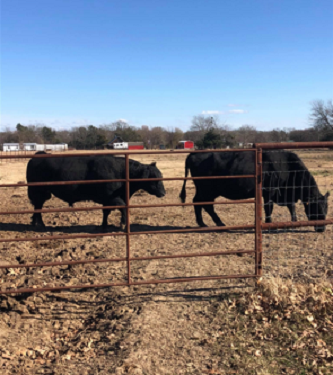December 5, 2023 – Winter cattle feeding can be challenging when forage supply is short. It is also common that during the winter feeding process that cattle has the tendency to look for green forages to consume causing challenges to fences to keep them confined. When cattle breaks loose, the nature of the consumed forage becomes unknown. It is during these circumstances when intoxication can become a problem, either by the ingestion of known toxic plants or non toxic plants with toxicans in them. Two common toxic compounds for cattle are nitrites and prussic acid. Ammonium nitrogen is the preferred form of nitrogen for plant growth, but nitrate nitrogen is the form primarily taken up by plants. Even when ammonium and urea-based fertilizers are applied, most of the nitrogen taken up by plants is in the nitrate form because soil microorganisms quickly convert ammonium nitrogen to nitrate nitrogen. Nitrates are extremely soluble in water and are easily absorbed by plant roots along with soil moisture. Normally, plants reduce nitrates to ammonium ions and then assimilate them into amino acids and other proteins. This process, called nitrate reductase, occurs in the roots of some grasses such as bermudagrass, and in the leaves, stems and stalks of plants such as corn or sorghum. When plants are stressed (for example, by drought) this process slows or stops, allowing nitrates to accumulate. Here are some conditions that cause nitrate accumulation: 1. When the temperature is high and moisture is adequate, plants may undergo a process called photorespiration. Photorespiration produces carbon dioxide rather than assimilating carbon into energy building blocks (i.e., sugars, carbohydrates, etc.). This may cause nitrates to accumulate. 2. When the soil contains nitrate nitrogen but little soil moisture, nitrates are highly concentrated in the water plants take up. Plants don’t have enough water to continue growing and nitrates accumulate. 3. Herbicide injury can limit the conversion and assimilation of nitrates in plants. After herbicide applications, check the field, especially field edges, for forage plants affected by off-target herbicide drift. Three to 5 days of active growth are needed to significantly reduce nitrate levels in plants.
Prussic acid in forages can pose a significant risk to certain grazing and barnyard livestock. Under normal conditions, when these plants are actively growing and healthy, they contain low levels of prussic acid because the compound breaks down over time, thus eliminating toxic accumulations. Unlike nitrate, prussic acid may be present for a while and then dissipate from plants properly cured for hay. Prussic acid accumulation can happen when: a) There are poor growing conditions that prevent stems from developing properly b) Recent hay harvest or grazing causes slow and stunted growth of new plant tissue c) Nitrogen fertilizers are over-used or there are other soil fertility or nutrient imbalances. C) Plants develop new growth after a prolonged drought. Livestock poisoned by prussic acid have respiratory stress similar to that caused by nitrate poisoning. A blood test can quickly distinguish between nitrate and prussic acid poisoning. If prussic acid is the toxic agent the blood will be cherry red, unlike the chocolate brown blood seen in nitrate poisoning. Horses, hogs and other nonruminant animals are less affected by prussic acid because their stomachs convert the prussic acid to less toxic formic acid and ammonium chloride. For more information on this or any other agricultural topic please contact the Hopkins County Extension Office at 903-885-3443 or email me at [email protected].






